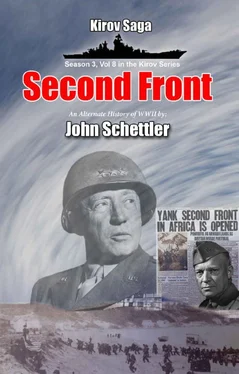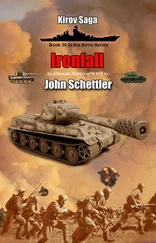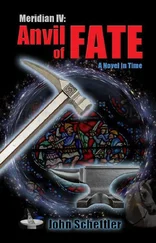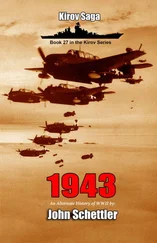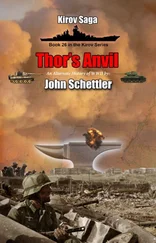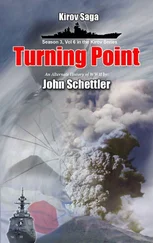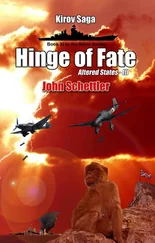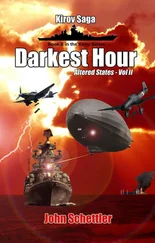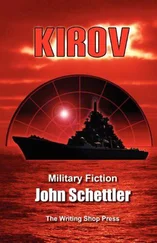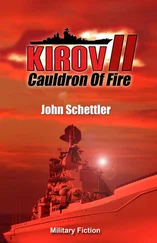Takami had been watching and waiting, cruising silently in EMCON about 40 kilometers south of Kurita’s surface action group. They had deployed a single helo, Sierra One, low and slow at first so as not to arouse undue suspicion, and it was loitering at about 2000 feet, a hundred kilometers to the northwest.
“So much for that dangling left jab,” said Fukada. “Those have to be S-300s, or even the newer S-400s. We could warn those planes to disperse. It might give them a ghost of a chance out there.”
“We’d have to blab that in the clear, or relay it through Kurita on the secure comm link. Neither case would matter much. Those missiles are too damn fast. I’m afraid they were too quick to get up there. We’re still too far south to use our missiles, and the naval air strike isn’t even on our screens yet.”
“Trying to coordinate this in EMCON is going to be like herding cats,” said Otani.
“True, but the more we say in the way of any radio traffic, the more chances they have to intercept a signal that gets their attention.”
“Let’s just hope they don’t give our Sea King the same treatment when they finish off those planes,” said Fukada.
“I doubt they’ll target that. They have to think it’s a seaplane, just a lone slow contact to their southwest. It’s no threat unless it comes with in visual range, and even then why would they care? Notice they haven’t thrown anything at Kurita either. But they have a helo up too, and so they know he’s there. Hell, they probably have us on the contact board as well, but as far as they are concerned we’re just another surface ship of this era. So far they’re acting as if they don’t know a thing, which is how we need to keep it until we get inside 120 klicks.”
“Then what?” said Fukada.
“Then we go active and throw everything we have at them.”
“What about Kurita?”
“What about him? You know damn well that Kirov won’t let him get anywhere close enough to use his main guns. As far as I’m concerned, it’s as if those ships weren’t even there. I think the Russians will take down any air threats, but probably make Kurita’s surface action group a second priority target.”
“And if they go after them with those Sunburns?”
“Then we have a choice to make. We have Kurita under our SM-2 umbrella. We could go active, get a fix on their missiles and fire.”
“That gives up the game from that point on.”
“Right,” said Harada. “The other choice is to do nothing, let Kurita take one on the chin and see how much iron he has there. We keep on north, fast and quiet, and get as close as we can to those bastards before we fire.”
“This is going to get ugly,” said Fukada, “and real fast. This ship was built for defense. Our entire loadout is based on that. Yet here we sit, trying to creep up and get inside on these guys with one good right hand. You realize that after we throw that punch, we’re done.”
“So we have to hope we land it,” said Harada. “After that, we could still use the SAMs in an anti-ship role. If nothing else it might keep them off balance.”
“We should use the rail gun.” Fukada folded his arms, eyeing the Captain. “We should use it the moment they put lead on any of Kurita’s ships. We fire that while our Type-12s are outbound, and before we do that, we have to take down their helicopter. That’s job one.”
“Agreed,” said Harada. “At least on the helo. As soon as we fire anything, the jig is up and we go to full active sensors. Then I’ll put an SM-3 on their helo and take out their eyes. That way they won’t pick up our SSMs until they get much closer. As for the rail gun, I’m not so sure it will do us any good, but we might get lucky.”
“It has them in range right now,” said Fukada.
“Right, but we don’t even have a hard fix on their location with all our sensors passive like this. If we fire it now, we just give them something to chew on if they pick up incoming rounds on their radar.”
“They may see them, but they’re too fast for them to do anything about it. That gun fires at Mach 7!”
“Correct, but that will sure prickle their curiosity. No. The less they know, the better. I want to sit tight until we’re ready to take our shot. After that, anything goes.” He looked at Hideo Honjo now. “Lieutenant, crack your knuckles and warm up those hands. We’ll be busy with the SM-2s as soon as they figure out what’s happening.”
“Ready sir,” said Honjo. “We’ll knock down anything they throw our way.”
It was all cat and mouse at this point, only the question remained—which one was the mouse? Kirov was a very big cat to be sure, with very sharp claws and teeth. Taking that cat by the tail was going to be very dangerous, and Harada knew that Kurita’s two battleships and three heavy cruisers would be nothing more than secondary targets. They could contribute nothing at all to the offense here, which would have to be carried by any aircraft they could shepherd to the target. He looked at his watch, wondering what was holding up the naval air strike. It was a sallow and cold thing to think now, but they needed to put as many targets into the air as possible. Kirov was already going after the land based planes, and he was beginning to have a very bad feeling about this whole setup.
Just let me get close enough to get the first punch in, he thought. In modern naval combat, it was always the struggle to get off the first salvo that mattered. His missiles were much slower than those Sunburns, so he needed to fire first, before he had to go defensive. That would be the best they could do, get that salvo in the air before the Russians figured out what they were up against. All it would take is a single hit, on either side, to decisively shift the balance here. Harada was praying for all he was worth that Takami would be the one to get that first hit.
Sea of Okhotsk, 20 May ~ 12:50
The battleship Haruna was in the number two position that morning, following in the wake of Kurita’s old ship, the heavy cruiser Mikuma . As one of Japan’s most modern ships, it even had radar installed, the Mark II, Model 1 Shipborne Air and Surface Search Radar, capable of seeing planes out to 90 kilometers, or ships at sea 18 kilometers away. Unfortunately, it was found to be useless that day, a clutter of static under the routine jamming Kirov was putting out on frequencies known to be used by the enemy at this time. Kurita’s ships would have to rely on another system, a highly refined sensor that was directly connected to a fairly complex computer, more complex, in fact, than any computer aboard Kirov that day.
It was installed on every mainmast in the task force, carefully searching the distant horizons in every direction. That system had come to be designated by a most iconic name in modern navy circles—the Mark 1 Eyeball, dual mounted on a swiveling platform called a head, and the complex computer it was connected to was the brain of the watchman inside that head. That was all Kurita had, the watchful eyes on his mainmast, their binoculars, their brains. Everything else was jammed and down, but the trusty Mark 1 Eyeball would see a good deal more than any man expected that day.
They had closed to about 42 kilometers from the estimated position of their adversary, still well over the horizon, and unseen. But the morning sky was soon alive with the hot long contrails of the S-300s, one following another, scoring the mid-day sky. Heads turned, eyes saw, brains reacted and the shouts of alarm soon followed— Rockets!
That was the word Kurita had been waiting to hear, and now he rushed out onto the weather deck off the bridge to put his own Mark 1 Eyeball into operation. There they were, those long ghostly contrails in the sky, but they were not aiming for his ships. Instead they were moving west towards the dark mass of Karafuto, and their speed was amazing.
Читать дальше
